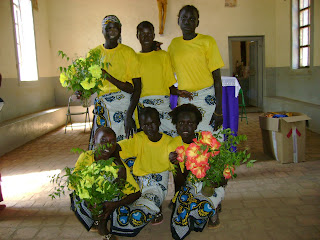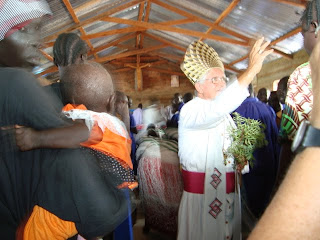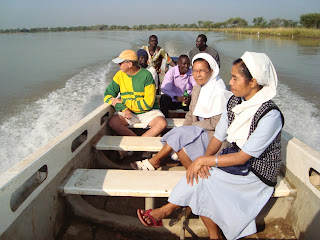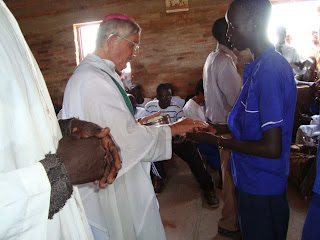St. Theresa Parish will celebrate its Diamond Jubilee -- 75 years -- On Oct. 1, 2009, with a Mass of the Patroness, entertainment and lunch. You are invited!A brief history of St. Theresa Catholic Church
Nyamlell (Aweil West)
Northern Bahr el Gazhal State
South Sudan
By Fr. Michael D. Barton, MCCJ.
There were definite plan to send Missionaries in 1927 but the Church authorities and the Superiors of the Comboni Missionaries changed their minds because Dem Zuber needed personal. Actually from documents beginning 1921 the Commissioner of Aweil asked missionaries to come.
So it was not till six years later that the Fathers arrived from Kwajok and in 1933 there were Muslims and a good number of Muslim Sympathizers who were mostly soldiers and government officials and a small number of Dinka Malual and a smaller number of Christians baptized in Kuajok.
The paramount chief was also badly disposed to the Catholic Mission and to their schools or any schools in the area.
Not with standing these difficulties it was on Ascensions Day 1933 three Combonis came to visit and celebrated the first Mass here and chose the site for the first Catholic Mission in the area now known as Northern Bahr el Gazhal or the then Districts of Aweil and Ariath.
A word must be said about these three great men who came to open the mission here. Father Angelo Arpe was later to become a martyr of the Catholic Faith as he was killed in Mboro on November 1st 1946 rather then break the seal of confession.
The other Father Eduardo Mason, a renounced educationist, was later one of the founders of the North American Province of the Comboni Missionaries and than in
1946 became the Bishop of Wau and then gave way for Bishop Ireneo Wien Dud Akot to take over the Wau Diocese and so went and became the first Bishop of El Obeid in Northern Sudan but was expelled from the Sudan in 1964.
Father Giuliano Ignazio Alghisi, who in 1934 really started the tough work of opening a new mission and became one of the first priests of Nyamlell along with talented Brother Julius Raimondo.
The first parish priest was the Reverend Father Nicoleo Olivetti with Brother Raimondi came to stay on 18th January 1934. A bell was put up on March 17th. 1934 and the Blessed Sacrament reserved. At the beginning of May came Father Alghisi and the first school year started with formal education with 12 pupils and then 25 but never passed 40.
There was little cooperation from the chiefs of the area to support the mission or to send their sons to school.
The great chief Majak, son of Akot, nephew of the great chief Ciak-Ciak. was very hostile to the missionaries and to the mission and on one day in 1936, as he was seated on is tribunal in a village just a few kilometres from the mission, and influenced greatly by beer said with a very loud voice that the missionaries were his slaves and he could and would put them in prison for lack of respect to his dignity any time that he pleased.
The very next day on ex-police men who had been unjustly imprisoned by the chief, rose up and killed the chief with a spear. Chief Majak’s body was brought to the mission on the way to his home village for burial when the fathers came out and prayed for his soul. This gave a good impression to the people of the area.
From 1934 to 1946 the total number of baptized in this 12 year period was right around 400 which is an average of about 33 baptisms per year. The school was frequented by only 60 – 90 boys per year in the best to 40 in the worst years. Tribal wars and conflicts also disturbed the mission many times. Those 12 years were tough and the fathers found the mud and flooded area quite difficult to get around on by bicycle or by car.
Few places welcomed them or accepted the Christian message .It must be noted that, Peth was the first to be opened to the gospel message. Then an old Dinka Malual woman had a dream near Nyamlell.
The Dinka believed is a supreme Divinity who helps them and their herds of cattle. So God – Nhialic and St. Theresa can continue to help and protect this same people of the Lol River and beyond.
One night an old lady – alone in the village in the area of Nyamlell- went to sleep in the same hut where her father had died and in a dream. So her dead father appeared to her and told her to go the mission. “What am I going to get there?” She asked him respectfully. The dead parent answered. “Good Mysterious water.” “The mission is the seat of God.” “The water of God which is good for your soul.”
She slept till morning and than went to talk to the father in the mission church who she had never met. Slowly but surely she and a group of old women joined a special catechumenate where they brought their children and grandchildren so Christianity began in our parish from above and not from below as it should have often when the fathers would go, to a new village, the village children would call out from afar: “ They have come to eat us.” People were very suspicious of the white missionaries every movement. They moved by bicycle, on foot. by a car or by boat to take Jesus every where in the 2 Districts under them to more then 150,000 people populating the area. They crossed the River Lol, waded through flooded plains for miles at a time sleeping in cattle camps, eaten by mosquitoes and affected by malaria and other tropical diseases, sleeping in huts and eating what is given them. At times even crossing the swamps with crocodiles; and also enjoying the wild game that was present then and sharing in the fishing festivals on the River Lol and other places that the Malual love so much. They went on the mission with joy in order to establish the Catholic Church of Christ and the Apostles in the South Sudan.
In 1946 a new District Commissioner was appointed, and he ordered the locals chiefs to collaborate with the mission and this gave impetus to increase the number of our schools and our chapels and even. indirectly to the number of Christians in the parish.
1946 also saw the Church built and Fr. Ercole De Marchi said the first Mass in it and dedicated it to Saint Theresa of the Child Jesus and became the first of Parish dedicated to her in the whole of the Sudan but was much later followed by the Cathedral of Juba in Kator, and later too the Cathedral in Arusha, Tanzania and Kisumu, Kenya. Fr. De Marchi died in Kampala in 1958 at 63 years of age.
In 1947 came Father Zecchen who would share with more the 500 fishermen all along the river in the fishing festivals.
In 1948 – came Fr. Joseph Cavallera and saw a growth of the school in Nyamlell to 128 and he started three out schools: a) Aguat b) Marial Baai and c) Ricithiec. Then in July to September he visited and spent the 3 months in Gok Macar walking in mud up to his neck. Then in Christmas of 1948 there were four baptisms from there.
April 1949 the school grew to 137 boys in Nyamlell and the same month of April 1949 the Governor General of the Sudan came from Khartoum to visit Nyamlell. He stayed in mission two days.
The school grew in Nyamlell to 137 and Fr. Calavera came to spend a week in the school of Marial Baai (25) and Aguat (50).
August of 1949 saw the fathers’ house and the church started in Mading Aweil, which is now the parish of Saint George.
Also here in Nyamlell on the 22nd November 52 children were baptised. In this same year 200 people were killed not far from Nyamlell due tribal and clan conflicts.
In the same 1949 was also the year that 5 boys indicated a desire to enter seminary of Bussere near Wau.
1950 – September 3rd, 1950 five lions visit the mission and visited all the dormitories of the schools.
1950 Christmas –There was a big gathering of over 500 Christians, pagans and chiefs. Many games and plays were performed but it was a cold Christmas. The chiefs gave 4 bulls.
17 October 1950 was first film ever shown in Nyamlell – showed by Father Simoni to great diversion and laughter.
4 November 1950, 30 were baptized.
1951 – 23 December, 52 baptisms
December 27th, 1951 coming from Aweil to Nyamlell for a few days rest and about 15 kilometres away from Nyamlell, Father Zannetti shot 2 elephants and 80 boys went to bring back the meat to the mission. The Christmas feast went on for many days.
Another very important event of 1952 was on February 24th 1952 with the Christians blessing of the River and its surrounding and not just the pagan traditions and was done with the permission and encouragement of the District Commissioner and led to the building of the present Shrine of the Sacred Heart of Jesus over looking the Lol River. It caused quite a controversy at the time between traditionalists and Christians.
The very next day on February 25th, 1952, there was a total eclipse of the sun by the shadow of the moon at 10:00 a.m. which lasted for 10 minutes. The local population of Nyamlell called out “apeth” as the sun was darkened and threw spears to kill the evil spirit which had taken the light away.
On the 17 April, 1952 there was a very serious out break of meningitis all ever the whole of the parish.
1st May the school year started with 245 children in six classes.
June 10th 1952 A Comboni Girls School opened by the Comboni Missionary Sisters with 35 girls. November 22nd the Sisters house and the girls’ dormitories were completed and ready for use.
December 23rd 1952, 52 boys were baptised and they were mostly from the school.
December 25th 1952 was another big Christmas celebration.
4 January 1953 - They was a great Marian Pilgrimage came to Nyamlell with the theme that Mary must prepare the way for her son to enter into the Dinka Culture.
22 January the school children went home for their long holiday and some of them walked for more than 100 kilometres.
1953 and onwards the school continued normally for period of nine months.
Others came to the mission for school and others came to live in the mission to receive Christian Doctrine Instruction. They world rise early and would go to the Church for Morning Prayer and to share in the Holy Sacrifice of the Mass which was always in Latin.
Then there would be one hour of Catechism teaching and breakfast would be served at 9:00 a.m. Work would be done in the mission garden and farm to 12.00. These gardens and field provided enough for the catechumens to eat and the school children too.
At 3:00 there would be Bible Studies followed by another hour of Catechism Teaching. Sports would be played from 5:00 – 6:30; At 7:00 there would be Rosary and Litany and Evening prayers. The teaching was given all in the mother tongue.
The Catechism was taught and the catechumen was prepared for Baptism, Confession and Holy Communion. These Catechumens would come from all over Aweil and Ariath, as Gordhim and Aweil began to function as mission-parishes beginning in the mid 1950’s. Before that everyone came to Nyamlell.
It was under Bishop Rudolph Orler that Nyamlell was founded in 1934 and he visited Nyamlell many times till his death in 1946. Bishop Mason took over in l946 and is reported to enjoy coming to Nyamlell to eat the papayas and eat the sweet fish of the River Lol. He once stated that Mading Aweil is for administration but Nyamlell is for the pastoral work.
1954 started the movement of independence and it was clear the Arabs were to be given control of the South Sudan.
This began to cause unrest. 1955 the church continued to take the root. Yet unrest among youth and intellectual was evident.
1956 the Sudan became united as one country and independence was granted to it.
1957 the Arab present was more and more felt and there were many restrictions on the missionaries Baptisms were restricted.
1958 the influence of the missionaries was greatly resented and the schools were nationalized. This was considered quite a blow to the Church.
1959 the fathers could not work in the schools and more time were given to visit the outstations and to work with prayer leaders and catechists.
1960 the Missionaries Act was in forced and more restriction were placed on the Foreign Priests, Brothers and Sisters.
1961 Bishop Mason left Wau for El Obeid and Bishop Ireneo Dud left Rumbek which he had founded in 1955 to take over Wau. He visited Nyamlell often and spoke Dinka well.
1962. The fathers were more and more restricted but still in the Church grew in many ways. Anyanya One spread from Equatoria to Bahr el Gazhal to Upper Nile and the Arab Governor accused the foreign missionaries of spreading this disunity.
1963. There was fighting in many areas and disrupted the schools but the pastoral work continued.
1964. February 29th of that year the fathers and brothers with all the CMS. Sisters are taken to Wau for immediate expulsion from the South and from the Sudan. Bishop Dud saw them off from Wau to Juba with tears in his eyes and then on to Khartoum and out of the Sudan.
1965. Fr. Barnabas Deng stayed as the only Catholic priest around and came to Nyamlell a few times from Aweil. After Fr. Angelo Arpe, Father Deng was the second Comboni martyr in the South Sudan and both had worked in Nyamlell. Father Barnabas was shot and killed near Wau on August 28th of 1965 by the military and his body never found.
1966. Very few visits both the missions of Gordhim and Nyamlell were badly looted mainly by the locals but also by the Arab forces of Khartoum. Almost all the things were stolen or destroyed.
1967. Years of War and isolation.
1968. Bishop Ireneo Dut came to celebrate the sacraments in Nyamlell after several years of none.
1969. Communication cuts even going and coming to Aweil were difficult and sporadic.
1970. The Signs peace talks gave hopes to many Southern Sudanese.
1971. Peace agreement of Addis Ababa, Ethiopia.
1972 – 1974 a few visits from the Sudanese priests in Aweil but very little Church life in the mission of Nyamlell.
1974. An old-boy of Nyamlell, Bishop Gabriel Zuber Wako became the bishop of Wau and Ireneo Wien Dut became Archbishop of Juba.
1975. All Vicariates in Sudan becomes dioceses and all the missions became parishes.
1976. Bishop Zuber and priests from Aweil come to visit but no parish priest is able to move to the now destroyed dilapidated mission compound.
1978 - 1981 Situation changed very little. Communication and travel became easier. Father of Aweil would come to visit Nyamlell – Day visits from time to time.
1981. Sudan celebrated the century of the death of Bishop Daniel Comboni, 1881 to 1981. Nyamlell old boy, Bishop Zuber leaves Wau and became the second Archbishop of Khartoum.
1982. Fr. Joseph Nyekindi became Bishop of Wau.
1983. Bishop Nyekindi visited Nyamlell for a short visit.
1984. Bishop Edward Mason visits Nyamlell for a short visit during a tour of all Bahr el Gazhal before returning to Italy and retirement.
1985. Sudan celebrated its first Eucharistic National Congress in every parish and diocese and finally as a national church in Juba on the feast of Christ the King.
1986. Sign a new war begin to show themselves.
1987. Simon Wol and some elders repair some building to restart education and schooling in Nyamlell.
1988. Schools starts and stops, starts and stops.
1989. Many small chapels start.
1990. Protestant church make their presence felt in the area.
1991. Simon Wol Mawien led many young boys and youth to training comps in Ethiopia.
1992. SPLA grows in strength from strength in the South and in Nyamlell.
1993. Lack of security in the whole area of the parish.
1994. Villages attack and the people flee to Darfur and Kordofan.
1995. Bishop Rudolf Deng Majak takes over Wau. Bishop Nyekindi go to Aweil and then to Abiei.
1995. Fr. Joseph Pellerino and Brother Dominic spent a few months living and working in Nyamlell. Many Baptisms and much hope but all stopped when in March, Muralin attacked Nyamlell and neighbouring villages and Nyamlell was abandoned again.
1997. Fr. William Can Achuil began to visit Nyamlell from his base in Malual Kon.
1998. Fr. Can returns to visit Adhal, Marial Baai, Peth etc. Many baptisms were performed.
1999. Bishop Caesar Mazzolari visited twice and on his visit on Palm Sunday has very serious heard problems.
2000. Jubilee Year; Young men are taken to Billing for training in Nursing School in Nyamlell opened again as a Church School and another in the old and another in the old convent as a government School. Fr. Mario and Fr. Benjamin Madhol Akot visit many areas the parish. This was all done under the auspices of the Diocese of Rumbek.
2001. Many catechists and teachers are sent for training to Kitale, Kenya as teachers and catechists.
2001. Fr. Thomas Oliha and Bishop Caesar visited for Christmas and over two thousand were baptised and confirmed, a new Pentecost in December for Nyamlell.
2002. Fr. Michael Barton begins work in school and in parish. Fr. Oman visits from Rumbek and baptised over 300 in Malual Loch, (ANC)
2003. Church repaired.
2004. School building repaired and revamped. John Goring de Maier visited in May 14th. CPA was welcomed in Nyamlell with much rejoicing and happiness.
DOR began clinic and then TB hospital in Nyamlell.
2005. Fathers’ House repaired in Nyamlell. Catechists had yearly training courses. First Class 8 in Nyamlell and scored # 1 in DOR and Marial Baai scored # 13.
2006. Sisters house repaired by Laurence and the coming of the OLSH Sisters from Indonesia. Second class 8 in Nyamlell and also scored # 1 in DOR and Marial Baai scored #11 and we also had the opening Sacred High School.
Cordaid take over some mission buildings and began their work.
2007. Other Schools open in Nyamlell. NGO’S become strong many catechists and teachers leave the Church work for them. There was the building of a permanent. School building in Marial Baai.
2008. High School building completed. 4 classrooms completed in Marial Baai. We celebrated the year of Saint Paul with Fr. Colombo. Class 8 Nyamlell scored # I in state primary external examinations. Goss starts to pay some teachers.
2009. Building of Saint Catherine Activity Centre of Marial Baai by Laurence and ladies. 75 years celebrated in our Parish of Nyamlell. There have been 15,737 entries and counting in the Baptismal Registration Book in the last eight years.
All mistakes and omissions and shortcomings in this brief history of our Parish of Nyamlell are mine.
















































